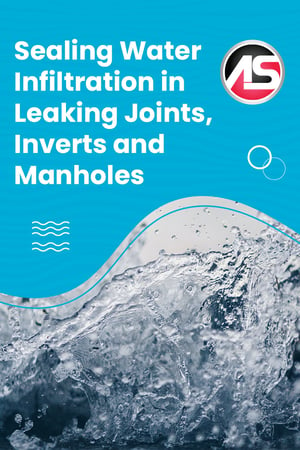
 Treatment plants undergo massive strain and efficiency issues when groundwater infiltrates city collection systems. These common problems lead to large expenses that can accumulate if left unchecked. Identifying the root causes and creating a plan to minimize the damages will be dependent on the scale of the problems, the age and condition of your overall infrastructure, and your budget. Having a trusted, experienced team of consultants will prove to be invaluable as you navigate these uncharted waters.
Treatment plants undergo massive strain and efficiency issues when groundwater infiltrates city collection systems. These common problems lead to large expenses that can accumulate if left unchecked. Identifying the root causes and creating a plan to minimize the damages will be dependent on the scale of the problems, the age and condition of your overall infrastructure, and your budget. Having a trusted, experienced team of consultants will prove to be invaluable as you navigate these uncharted waters.
What is Groundwater Infiltration?
Groundwater Infiltration is an industry term referring to groundwater improperly entering a sanitary sewer wastewater system. This water, which normally drains deep into the ground or is routed to storm drains, ends up being treated. This costly treatment will eat away at your already limited budget while also taking up precious capacity within your collection system. Some common ways groundwater can enter sewer pipes (interceptors, collectors, manholes, or side sewers) are through cracks, leaky pipe joints, connection failures, and poorly maintained manholes.
You may have groundwater infiltration issues if you notice any of the following signs:
- Your pipes are backed up during rainy seasons. This is often a good indicator of an unforeseen infiltration issue. During the next heavy rain, determine if your manholes are spilling wastewater onto local roadways or fields. This may be a good indicator that you have a surplus of groundwater infiltrating your wastewater systems.
- Your lift station pumps running continuously or cycling frequently. There may be an issue at hand if your lift station pumps run continuously for a long time after a typical rain event, or if your pumps start and stop frequently. Either event is likely happening because groundwater has entered your sanitary sewer system and is overloading your treatment centers.
- You can measure significant spikes in flow rates. As you measure and evaluate the effectiveness of your wastewater treatment plant during rainy or high groundwater conditions, readings that return abnormal spikes in inflow likely indicate an I&I issue. While small amounts of infiltration are to be expected, large spikes rarely happen unless there is a significant infiltration issue at hand.
6 Methods to Quantify Infiltration Issues
The warning signs noted above are helpful but indicate basic symptoms only. Once you’ve suspected that groundwater is infiltrating your system, there are 6 proven methods for capturing important data to determine the next course of action. These methods must be performed by a reputable engineering firm or a survey team.
- Sanitary sewer flow monitoring
- Manhole inspections and 3D technology
- Smoke testing
- Dye testing
- Pipe inspection/closed circuit television inspection (CCTV)
- Private property inspections
Cost-Effective and Proven Solutions to Stop Infiltration Immediately
These groundwater infiltration points can be permanently sealed off with crack/joint injection & curtain wall procedures using water-activated polyurethane foam. Pressure injection of these liquid polyurethane resins forces the material into leaking cracks, joints, or voids behind leaking structures. After the polyurethane injection is complete, the polyurethane resin rapidly reacts with water to form a watertight seal.
These leaks can be repaired with a small crew of about three people. A repair crew this size typically averages about two manholes per day (depending on manhole size and proximity). On average, curtain wall grouting a 4-foot diameter x 8-foot tall manhole requires 5 gallons of Spetec PUR HighFoamer. On average, treating joints and pipe penetrations on a 4-foot diameter x 8-foot tall manhole requires 2.5 gallons of Spetec PUR GT380.
- Failing Sewer Pipe Joints: Groundwater rising and falling puts hydrostatic pressure on pipe and manhole joints, causing them to fail. Point grouting consists of driving injection pipes to the points of failure and injecting a resin such as Spetec PUR HighFoamer. The resin expands and cures quickly to seal off the leaks and fill voids in the soil. Filling the voids with a grout like Spetec PUR HighFoamer also reduces the hydrostatic pressure on the joints. The grout also permeates the soil and increases the load-bearing capacity which can prevent future misalignment of the pipes.
- Pipe and Manholes Inverts: For many years, inverts have been repaired with hydraulic cement. But hydraulic cement fails if there is structural movement over the long-term, and thus leaking cracks/joint return. While hydraulic cement is cheap, repeating the repair process over and over is very expensive and means more confined space entries. Injecting the joints and inverts with a flexible polyurethane grout will provide a long-term repair, often longer than the expected service life of the manhole. Spetec PUR GT380 is the gold standard for these types of repairs, but at times a hydrophobic grout might be needed and thus Spetec PUR F400 would be the grout of choice. With the F400 different reaction times are possible by adjusting the percentage of GEN ACC Accelerator.
- Precast Manhole Joints: A factory-trained specialty contractor can seal precast manhole joints using Spetec PUR GT380. It is a hydrophilic polyurethane material that cures to form a gel or a foam. Because it's a single-component material, you can install it easily without the need for mixing. It can easily penetrate joints before it eventually cures into place, thanks to its low viscosity. Spetec PUR GT380 is a durable, long-term sealing solution that holds up against the harsh sewer environment.


